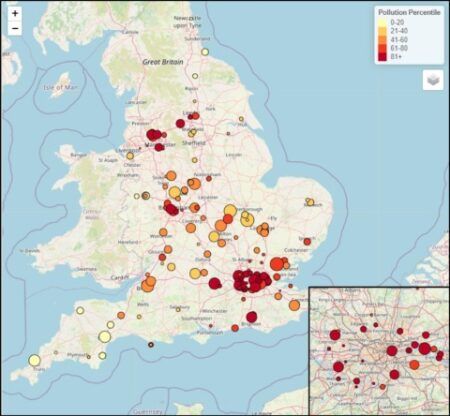Research finds all new schools in England are in areas of high pollution

A map showing the geographical spread of the schools in the study
New research from Evelina London Children’s Hospital and King’s College London has found that all new schools proposed to be built between 2017-2025 are currently, or will be in, areas of high pollution.
Published in the Archives of Disease in Childhood, the study analysed the air quality data from the sites for 147 new primary and secondary schools in England proposed or built between 2017-2025.
Air quality data was identified against the three World Health Organisations’ air quality guidance targets for particulate matter known as PM2.5 and PM10, and nitrogen dioxide (NO2).
Particulate matter is made up of microscopic pieces of liquids or solids that are in the air, such as dust or smoke.
And the results found that every school location exceeded at least one of the World Health Organisation’s air quality targets, and 86% exceeded all three.
Only six locations breached just one target – four in the South West, one in the South East, and one in the Midlands.
Schools with elevated levels of pollution were clustered in major English cities, including London, Liverpool, Birmingham, Manchester, and Leeds.
According to the World Health Organisation, PM2.5 is the most-dangerous pollutant as it can pass through the lungs into the blood system.
Children are more susceptible to the effects of air pollution, due to their developing tissue still undergoing biological changes.
Also due to their size, they are closer to the level of traffic fumes and higher concentrations of pollutants.
The health effects include higher incidence of asthma, increased sensitivity to allergens, more frequent and serious respiratory conditions, and pneumonia.
And long-term consequences include reduced lung function, low birth weight, and increased risk of chronic obstructive pulmonary disease and heart conditions, as well as adverse effects to concentration levels, cognition, and mental health.
Analysis found there is no mandatory guidance for school proposals to consider air quality levels during the planning stages of assessing the suitability of the site.
And building regulations recommendations regarding air quality are also outdated and likely to be ineffective.
Dr Meredith Robertson, lead author and paediatric respiratory consultant at Evelina London Children’s Hospital, said: “This study highlights that the current guidance does not go far enough to protect children and young people from breathing in harmful levels of pollution while in school.
“We miss key opportunities to reduce exposure to pollution which could be addressed by improving building design and other interventions.
“There are significant steps that can be undertaken to reduce pollution within the classroom, even if outdoor pollutants remain high. Therefore, it is imperative that we ensure safe indoor air quality in newly built schools.”
Previous analysis by City Hall in 2021 found that 3.1 million children in England are attending schools in areas with unsafe levels of air pollution, exceeding the World Health Organisation’s target for PM2.5 levels.
Evelina London, part of Guy’s and St Thomas’ NHS Foundation Trust, provides specialist cardiovascular and respiratory care at both the purpose-built children’s hospital on the St Thomas’ Hospital site and at Royal Brompton and Harefield hospitals.
